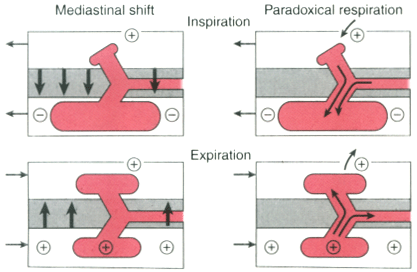 |
 |
Figure 49-8
Schematic representation of mediastinal shift and paradoxical
respiration in a spontaneously ventilating patient with an open chest who is placed
in the lateral decubitus position. The open chest is always exposed to atmospheric
pressure (+). During inspiration, negative pressure (-) in the intact hemithorax
causes the mediastinum to move downward (mediastinal shift). In addition, during
inspiration, movement of gas from the nondependent lung in the open hemithorax into
the dependent lung in the closed hemithorax and movement of air from the environment
into the open hemithorax cause the lung in the open hemithorax to collapse (paradoxical
respiration). During expiration, relative positive (+) pressure in the closed hemithorax
causes the mediastinum to move upward (mediastinal shift). In addition, during expiration,
gas moves from the dependent lung to the nondependent lung and from the open hemithorax
to the environment; consequently, the nondependent lung expands during expiration
(paradoxical respiration). (From Benumof JL: Anesthesia for Thoracic Surgery.
Philadelphia, WB Saunders, 1987.)

 |
